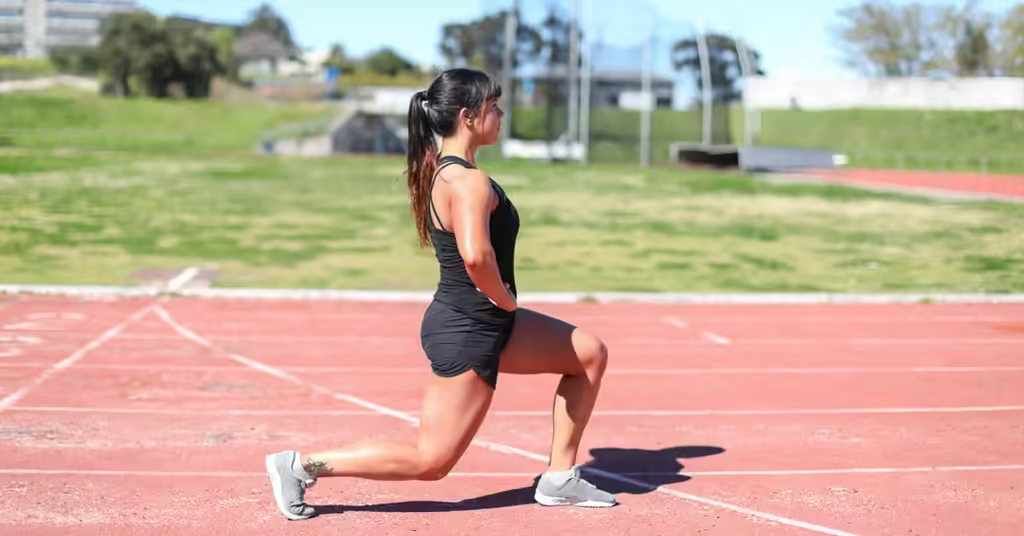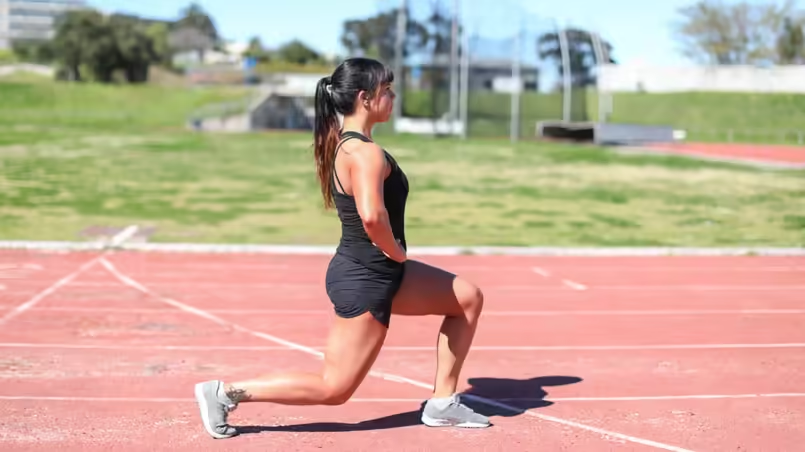
Presentation
Walking Lunges are one of the best activities for developing lower body fortitude, further developing equilibrium, and improving practical wellness. This compound development focuses on various muscle gatherings, including the quads, hamstrings, glutes, and calves, making it a fundamental activity for anybody hoping to foster areas of strength for a conditioned lower body. Whether you’re a novice or a high level competitor, integrating Walking Lunges into your wellness routine can offer a large number of advantages.
In this thorough aide, we’ll investigate the Walking Lunges practice exhaustively, covering its advantages, the muscles it targets, how to perform it accurately, normal errors to keep away from, varieties to challenge yourself, and ways to integrate it into your gym routine daily schedule.
1. Understanding the Walking Lunge
1.1 What is a Walking Lunge?
A Walking Lunge is a powerful variety of the standard fixed jump. In contrast to the fixed thrust, where you step forward and afterward return to the beginning position, the Walking Lunge includes a ceaseless positive headway. This additional component of velocity expands the test by connecting with settling muscles and requiring more noteworthy coordination and equilibrium.
1.2 Muscles Focused on by Walking Lunges
Walking Lunges are a compound activity that draws in a few muscle bunches all the while. The essential muscles worked include:
Quadriceps: Situated at the front of the thigh, the quadriceps are vigorously connected with during the bringing down period of the jump.
Hamstrings: These muscles at the rear of the thigh work to control the development as you step forward and bring down your body.
Glutes: The gluteus maximus, medius, and minimus are completely actuated during jumps, particularly while driving over the ground to step forward.
Calves: The calves assist with settling the lower leg joint and add to the push-off stage.
Center: The center muscles, including the abs and obliques, are locked in to keep up with equilibrium and steadiness during the activity.
2. Advantages of Walking Lunges
2.1 Reinforcing the Lower Body
Walking Lunges are a strong activity for developing lower body fortitude. By focusing on the significant muscles in the legs, they assist with creating strength and power, which is fundamental for exercises like running, bouncing, and crouching.
2.2 Further developing Equilibrium and Solidness
The unique idea of Walking lunges difficulties your equilibrium and coordination. As you push ahead, your body needs to balance out itself, drawing in the center and little settling muscles around the hips and knees. This superior strength can mean better execution in different activities and day to day exercises.
2.3 Upgrading Utilitarian Wellness
Walking Lunges imitate developments we act in day to day existence, like Walking, climbing steps, and bowing down to get objects. This makes them a practical activity that works on your capacity to perform ordinary errands easily and diminished chance of injury.
2.4 Expanding Adaptability and Portability
Walking Lunges assist with working on the adaptability and portability of the hip flexors, hamstrings, and quadriceps. The full scope of movement engaged with each step extends these muscles, which can be especially helpful for people with tight hips or restricted lower body versatility.
2.5 Helping Cardiovascular Perseverance
Performing Walking Lunges over a more drawn out distance or in a high-reiteration set can hoist your pulse, giving a cardiovascular test notwithstanding the strength benefits. This makes Walking Lunges an extraordinary activity for those hoping to further develop their general wellness level.
2.6 Supporting Weight reduction and Fat Consuming
As a compound development that connects with different huge muscle gatherings, Walking Lunges consume a lot of calories. When joined with a legitimate eating regimen and ordinary work-out everyday practice, they can add to fat misfortune and a less fatty body.
3. Instructions to Perform Walking Lunges Accurately
3.1 Bit by bit Directions
Beginning Position: Stand upstanding with your feet hip-width separated. Keep your chest lifted, shoulders back, and center locked in. You can put your hands on your hips or hold them at your sides for balance.
Initial Step: Move forward with your right foot. Guarantee your step is long enough with the goal that your front knee adjusts straight over your lower leg when you bring down your body.
Bring down Your Body: Curve the two knees to bring down your body into a rush. Your back knee ought to float simply over the ground, and your front thigh ought to be lined up with the floor. Keep your middle upstanding and abstain from inclining forward.
Push Off and Step in the right direction: Push through the impact point of your front foot to lift your body and present your back leg. Step forward into the following thrust with your left foot.
Proceed with the Development: Rehash the cycle, rotating legs as you push ahead. Keep up with great structure all through every reiteration, guaranteeing that your knees don’t implode internal and your back stays straight.
3.2 Breathing Method
Appropriate breathing is critical during Walking Lunges. Breathe in as you bring down your body into the jump, and breathe out as you push off and step forward. This breathing example settles your center and gives the important oxygen to muscle commitment.
4. Normal Missteps to Keep away from
4.1 Permitting the Knee to Stretch out Past the Toe
Perhaps of the most widely recognized botch in Walking Lunges is permitting the front knee to stretch out past the toes during the jump. This can overwhelm the knee joint, expanding the gamble of injury. To keep away from this, guarantee your front knee remains straight over your lower leg all through the development.
4.2 Inclining Forward
Inclining excessively far forward during the rush can decrease the viability of the activity and strain your lower back. Center around keeping your chest lifted and your middle upstanding to connect with the right muscle gatherings.
4.3 Making Short Strides
Making short strides can restrict the scope of movement and lessen the commitment of the objective muscles. Ensure each step is sufficiently huge to permit your front thigh to arrive at an equal situation with the floor during the jump.
4.4 Not Connecting with the Center
Neglecting to connect with the center can prompt unfortunate equilibrium and strength during the activity. Continuously keep your center muscles enacted to keep up with legitimate structure and control.
4.5 Hurrying Through the Development
Walking Lunges ought to be performed with controlled and intentional developments. Racing through the activity can prompt unfortunate structure and decreased adequacy. Center around each step and guarantee you complete the full scope of movement.
5. Walking Lunge Varieties
To keep your exercises testing and forestall levels, take a stab at integrating these Walking Lunge varieties into your everyday practice:
5.1 Converse Walking Lunges
In this variety, rather than venturing forward, you step in reverse into a rush. Invert Walking Lunges put a more noteworthy accentuation on the glutes and hamstrings and can be simpler on the knees for certain people.
5.2 Weighted Walking Lunges
Adding hand weights or a hand weight to your Walking Lunges expands the obstruction and difficulties your muscles significantly further. Begin with light loads and steadily increment as you develop fortitude.
5.3 Walking Lunges with a Contort
To connect with your center much more, play out a wind at the lower part of each jump. As you thrust forward, bend your middle towards the front leg, drawing in your obliques. Get back to the middle as you push off and step forward with the following leg.
5.4 Plyometric Walking Lunges
For a cardio support, attempt plyometric Walking Lunges. In the wake of bringing down into the rush, detonate upwards and switch legs mid-air, arriving in a jump with the contrary leg forward. This variety further develops power and nimbleness.
5.5 Side Walking Lunges
Side Walking Lunges focus on the inward and external thighs, alongside the glutes. Rather than venturing forward, move toward the side and lower into a horizontal thrust, then step the other foot in and rehash on the contrary side.
6. Integrating Walking Lunges into Your Gym routine Everyday practice
6.1 As A feature of a Lower Body Exercise
Walking Lunges are an incredible expansion to any lower body exercise. You can perform them as an independent activity or join them with other lower body developments like squats, deadlifts, and leg presses.
Model Daily practice:
Warm-up: 5-10 minutes of light cardio (running, cycling)
Squats: 3 arrangements of 10-12 reps
Walking Lunges: 3 arrangements of 12-15 reps for each leg
Deadlifts: 3 arrangements of 8-10 reps
Leg Press: 3 arrangements of 10-12 reps
Cool-down: 5-10 minutes of extending
6.2 As A feature of a Full-Body Exercise
To boost productivity, Walking Lunges can be incorporated into a full-body exercise. Match them with chest area and center activities for a decent daily schedule.
Model Daily practice:
Warm-up: 5-10 minutes of light cardio
Push-Ups: 3 arrangements of 12-15 reps
Walking Lunges: 3 arrangements of 12-15 reps for each leg
Pull-Ups: 3 arrangements of 8-10 reps
Board: 3 arrangements of 30-60 seconds
Cool-down: 5-10 minutes of extending
6.3 As a Warm-Up or Chill Off Exercise
Walking Lunges can likewise be utilized as a component of your warm-up or chill off daily schedule. Performing them with body weight and an emphasis on scope of movement can assist with setting up your muscles for more extreme action or help in recuperation.
Model Warm-Up:
Light running: 5 minutes
Walking Lunges: 2 arrangements of 10 reps for every leg
Arm circles: 2 arrangements of 10 reps for each course
Hip circles: 2 arrangements of 10 reps for each heading
7. Methods for Advancing and Improving Your Walking Lunges
7.1 Progressively Increment Distance or Reps
To keep gaining ground, slowly increment the distance you cover with Walking Lunges or the quantity of reiterations you perform. Begin with a reasonable distance and mean to add a couple of additional means every week.
7.2 Add Opposition
As you become more OK with bodyweight Walking Lunges, consider adding protection from increment the power. Hand weights, iron weights, or a weighted vest can give an additional test and advance muscle development.
7.3 Spotlight on Structure
Never penance structure for extra reps or distance. Legitimate strategy is essential for forestalling injury and expanding the advantages of the activity. On the off chance that you find your structure disintegrating, decrease the force or enjoy some time off.
7.4 Integrate Walking Lunges into Stop and go aerobic exercise (HIIT)
Walking Lunges can be a significant expansion to HIIT exercises. Perform them at a high speed for a set period (e.g., 30 seconds) trailed by a brief reprieve, then, at that point, rehash. This approach consolidates strength preparing with cardiovascular molding.
7.5 Use Walking Lunges for Dynamic Recuperation
On days when you’re not doing extreme exercises, Walking Lunges can be utilized as a functioning recuperation work out. Perform them at a sluggish, controlled speed to increment blood stream and help muscle recuperation.
End
Walking Lunges are a flexible and successful activity that can be adjusted to suit any wellness level. They offer a large number of advantages, from developing lower body fortitude and further developing equilibrium to improving utilitarian wellness and supporting weight reduction. By integrating Walking Lunges into your exercise routine daily schedule, you can take your wellness to a higher level and accomplish a more grounded, more conditioned lower body.
Keep in mind, consistency and legitimate structure are critical to receiving the full rewards of Walking Lunges. Whether you’re a novice or an accomplished competitor, this exercise ought to be a staple in your wellness routine. So trim up your shoes, step forward, and begin jumping your method for bettering wellbeing and wellness!


